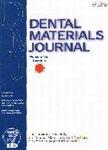版权所有:内蒙古大学图书馆 技术提供:维普资讯• 智图
内蒙古自治区呼和浩特市赛罕区大学西街235号 邮编: 010021

作者机构:Department of Chemistry Faculty of Science Kasetsart University Bangkok10900 Thailand Center of Excellence for Innovation in Chemistry Faculty of Science Kasetsart University Bangkok10900 Thailand Research Center Faculty of Dentistry Mahidol University Bangkok10400 Thailand Department of Biochemistry Faculty of Science Kasetsart University Bangkok Thailand Faculty of Science Kasetsart University Bangkok Thailand Genetic Engineering and Bioinformatics Program Graduate School Kasetsart University Bangkok Thailand Nakhon Ratchasima30000 Thailand
出 版 物:《Dental Materials Journal》 (Dent. Mater. J.)
年 卷 期:2025年第44卷第2期
页 面:190-200页
核心收录:
学科分类:0831[工学-生物医学工程(可授工学、理学、医学学位)] 0710[理学-生物学] 1002[医学-临床医学] 0804[工学-仪器科学与技术] 100212[医学-眼科学] 0836[工学-生物工程] 0803[工学-光学工程] 10[医学]
基 金:This research is funded by Kasetsart University through the Graduate School Fellowship Program the International Affair Division via the Capacity Building of KU Students on Internationalization Program (KUCSI) and the NSRF via the Program Management Unit for Human Resources & Institutional Development Research and Innovation [grant number: BO5F640161]. Additionally the research extends its gratitude for the financial assistance received from the Center of Excellence for Innovation in Chemistry (PERCH-CIC) Ministry of Higher Education Science Research and Innovation
摘 要:Bioactive fillers in dental adhesives are designed to release beneficial ions, such as calcium and phosphate, to help in remineralization process, and preventing secondary caries. Their incorporation also aims to improve the longevity of dental restorations. Herein, CaP nanoparticles were synthesized through a water-in-oil emulsion method using Tween80 as a surfactant and methacrylic acid (MAA). MAA officiated as a co-surfactant and reduced the size of CaP nanoparticle, including improved compatibility with the components of dental adhesive. The incorporation of 2% T80/CaP/MAA nanofillers into dental adhesive demonstrated increased efficiency, as evidenced by a higher degree of conversion (%DC) and greater micro-tensile bond strength (μTBS). More importantly, T80/CaP/ MAA nanofillers were able to induce remineralization process in the dental structure, which was confirmed by EDX mapping and IR imaging. Finally, a cytotoxicity assessment of the dental adhesive containing T80/CaP/MAA showed no significant adverse effects on human fibroblast cells. © 2025, Japanese Society for Dental Materials and Devices. All rights reserved.